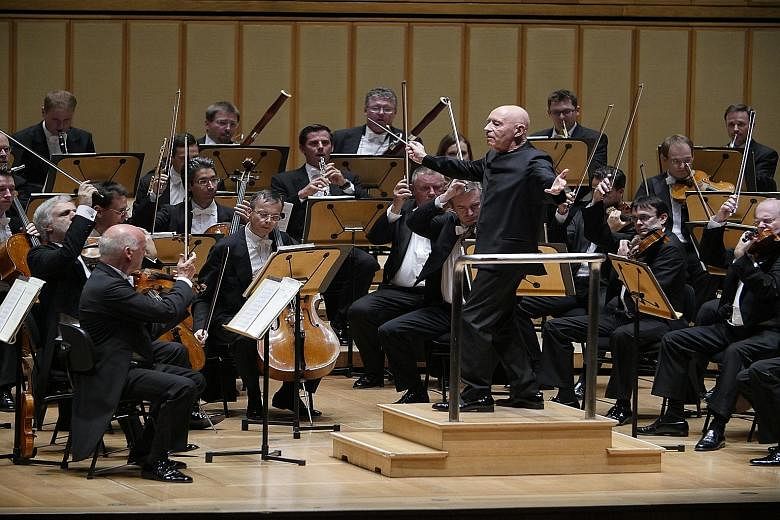REVIEW / CONCERT
VIENNA PHILHARMONIC ORCHESTRA
Vienna Philharmonic Orchestra,
Christoph Eschenbach - conductor
Esplanade Concert Hall
Last Saturday
The Vienna Philharmonic Orchestra play by their own rules, at the core of which is the "Vienna sound", an outcome of well-agreed bowing and fingering techniques among the strings, and the choice of instruments used, such as Vienna model rotary valved trumpets and piston valved, small bore horns.
How the orchestra works with conductors also stands out. They have never appointed principal conductors, and have worked only with guest conductors for their subscription and touring concerts since 1934. German-born conductor Christoph Eschenbach led this 2015 Asian tour of Japan, South Korea, Taiwan and Singapore.
He had a very successful earlier career as a pianist, and reprised this role as soloist-director in Mozart's Piano Concerto No. 23, a work in which the composer substituted oboes with clarinets, and dispensed with trumpet and timpani in the orchestra, lending a rounder, more elegant accompaniment for the piano.
The musicians were impressive from the start, playing with utmost polish and elegance, but also with articulation and bite, fully bringing out the changes in tension as the music flowed between major and minor harmonies.
Eschenbach, on the other hand, appeared resolute in emphasising the grace and beauty of the piano part, and was content to avoid excitement in his solos. His playing was technically excellent, but for all the flawless runs and delicate fingering, his solo lacked colour in comparison with the committed playing of his orchestral partners.
His conducting in the second half was a stark contrast.
The Russian composer Tchaikovsky hugely admired Mozart, and this is echoed in the opening movement of his Serenade For Strings, although the work takes on more of the composer's own style with the ensuing three movements.
Much of Eschenbach's conducting has been of music from the Romantic period, and he directed a reading of the utmost beauty, full of grand lyricism and unashamedly dramatic shifts in tempo.
The ensemble was still small by contemporary standards, but the way it filled the hall with its luscious string sound was magical.
Pizzicatos (plucked notes) were palpable, and the four double basses produced a deep sonority that other groups work hard to achieve at the Esplanade with sections twice the size.
Prokofiev's "Classical" Symphony also harks back to music of an earlier time - in this instance, that of Haydn.
The work provides ample opportunities for all sections to shine, and the musicians certainly did so, especially the flutes and bassoons.
Eschenbach's tempos for this work were a shade under what many conductors choose these days, and his interpretation had a romantic edge, but who can complain when the music is delivered with such pristine and spirited playing?
The concert, especially the second half, reaffirmed why music lovers yearn to hear the orchestra live in concert. The "Vienna" sound, the style and the class, they were all there in spades.
It was a pity that some five to six rows of the highest-priced seats were empty, although all other sections were packed.
Many Singaporeans know their music well and will pay for great concerts, but it seems that expecting so many to part with $400 a seat was ambitious, even with the draw of the incomparable Vienna Philharmonic Orchestra.

